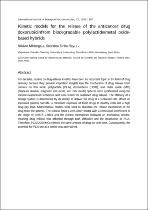 ResearchSpace
ResearchSpace
Kinetic models for the release of the anticancer drug doxorubicin from biodegradable polylactide/metal oxide-based hybrids
JavaScript is disabled for your browser. Some features of this site may not work without it.
- ResearchSpace
- →
- Research Publications/Outputs
- →
- Journal Articles
- →
- View Item
| dc.contributor.author |
Mhlanga, N

|
|
| dc.contributor.author |
Ray, SS

|
|
| dc.date.accessioned | 2016-06-27T08:44:22Z | |
| dc.date.available | 2016-06-27T08:44:22Z | |
| dc.date.issued | 2015-01 | |
| dc.identifier.citation | Mhlanga, N. and Ray, S.S. 2015. Kinetic models for the release of the anticancer drug doxorubicin from biodegradable polylactide/metal oxide-based hybrids. International Journal of Biological Macromolecules, 72, 1301-1307 | en_US |
| dc.identifier.issn | 0141-8130 | |
| dc.identifier.uri | http://www.sciencedirect.com/science/article/pii/S0141813014007144 | |
| dc.identifier.uri | http://hdl.handle.net/10204/8596 | |
| dc.description | Copyright: 2015 Elsevier. Due to copyright restrictions, the attached PDF file only contains the abstract of the full text item. For access to the full text item, please consult the publisher's website. The definitive version of the work is published in the International Journal of Biological Macromolecules, 72, 1301-1307 | en_US |
| dc.description.abstract | For decades, studies on drug-release kinetics have been an important topic in the field of drug delivery because they provide important insights into the mechanism of drug release from carriers. In this work, polylactide (PLA), doxorubicin (DOX), and metal oxide (MO) (titanium dioxide, magnetic iron oxide, and zinc oxide) spheres were synthesised using the solvent-evaporation technique and were tested for sustained drug release. The efficacy of a dosage system is determined by its ability to deliver the drug at a sustained rate, afford an increased plasma half-life, a minimum exposure of toxic drugs to healthy cells and a high drug pay load. Mathematical models were used to elucidate the release mechanism of the drug from the spheres. The release fitted a zero-order model with a correlation coefficient in the range of 0.9878–0.9891 and the release mechanism followed an anomalous release, meaning drug release was afforded through both diffusion and the dissolution of PLA. Therefore, PLA/DOX/MO released the same amount of drug per unit time. Consequently, the potential for PLA use as a carrier was ascertained. | en_US |
| dc.language.iso | en | en_US |
| dc.publisher | Elsevier | en_US |
| dc.relation.ispartofseries | Workflow;16390 | |
| dc.subject | Polylactide | en_US |
| dc.subject | Sustained delivery | en_US |
| dc.subject | Doxorubicin | en_US |
| dc.subject | Titanium dioxide | en_US |
| dc.subject | Iron oxide | en_US |
| dc.subject | Zinc oxide | en_US |
| dc.title | Kinetic models for the release of the anticancer drug doxorubicin from biodegradable polylactide/metal oxide-based hybrids | en_US |
| dc.type | Article | en_US |
| dc.identifier.apacitation | Mhlanga, N., & Ray, S. (2015). Kinetic models for the release of the anticancer drug doxorubicin from biodegradable polylactide/metal oxide-based hybrids. http://hdl.handle.net/10204/8596 | en_ZA |
| dc.identifier.chicagocitation | Mhlanga, N, and SS Ray "Kinetic models for the release of the anticancer drug doxorubicin from biodegradable polylactide/metal oxide-based hybrids." (2015) http://hdl.handle.net/10204/8596 | en_ZA |
| dc.identifier.vancouvercitation | Mhlanga N, Ray S. Kinetic models for the release of the anticancer drug doxorubicin from biodegradable polylactide/metal oxide-based hybrids. 2015; http://hdl.handle.net/10204/8596. | en_ZA |
| dc.identifier.ris | TY - Article AU - Mhlanga, N AU - Ray, SS AB - For decades, studies on drug-release kinetics have been an important topic in the field of drug delivery because they provide important insights into the mechanism of drug release from carriers. In this work, polylactide (PLA), doxorubicin (DOX), and metal oxide (MO) (titanium dioxide, magnetic iron oxide, and zinc oxide) spheres were synthesised using the solvent-evaporation technique and were tested for sustained drug release. The efficacy of a dosage system is determined by its ability to deliver the drug at a sustained rate, afford an increased plasma half-life, a minimum exposure of toxic drugs to healthy cells and a high drug pay load. Mathematical models were used to elucidate the release mechanism of the drug from the spheres. The release fitted a zero-order model with a correlation coefficient in the range of 0.9878–0.9891 and the release mechanism followed an anomalous release, meaning drug release was afforded through both diffusion and the dissolution of PLA. Therefore, PLA/DOX/MO released the same amount of drug per unit time. Consequently, the potential for PLA use as a carrier was ascertained. DA - 2015-01 DB - ResearchSpace DP - CSIR KW - Polylactide KW - Sustained delivery KW - Doxorubicin KW - Titanium dioxide KW - Iron oxide KW - Zinc oxide LK - https://researchspace.csir.co.za PY - 2015 SM - 0141-8130 T1 - Kinetic models for the release of the anticancer drug doxorubicin from biodegradable polylactide/metal oxide-based hybrids TI - Kinetic models for the release of the anticancer drug doxorubicin from biodegradable polylactide/metal oxide-based hybrids UR - http://hdl.handle.net/10204/8596 ER - | en_ZA |





